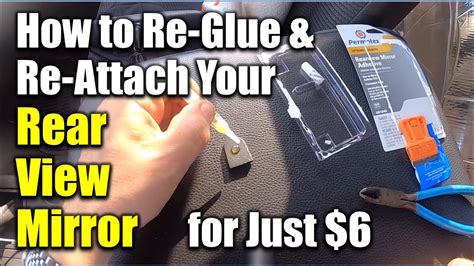DIY Rear View Mirror Repair: Save Money and Time
Replacing or repairing a damaged rearview mirror can seem daunting, leading many to immediately book a costly appointment with a mechanic. But with a little patience and the right tools, you can often tackle this repair yourself, saving significant money and time. This guide will walk you through common rearview mirror problems and how to fix them, empowering you to take control of your car's maintenance.
Why Repair Your Rearview Mirror Yourself?
The cost of professional rearview mirror repair or replacement can vary widely depending on the vehicle and the extent of the damage. You could easily pay between $100 and $500, or even more for luxury vehicles or complex repairs. Performing the repair yourself can save you a considerable amount of this expense, allowing you to allocate your budget elsewhere. Furthermore, DIY repairs often allow for more flexibility in scheduling – you can fix it at your convenience, rather than waiting for an appointment slot.
Common Rearview Mirror Problems and Their DIY Solutions
This section addresses some of the most frequently encountered rearview mirror issues and provides practical DIY solutions.
1. Loose or Wobbly Mirror:
This is often the simplest issue to fix. A loose mirror usually indicates that the mounting screws or clips have loosened over time.
- How to fix: Begin by carefully inspecting the mirror's mounting points. You might need a small flathead screwdriver or similar tool to gently pry open any decorative trim concealing the screws. Once you have access, tighten the screws securely. If screws are stripped, consider using a slightly larger screw, or even applying a dab of strong adhesive (check for compatibility with your mirror's material) to further secure the connection. If the problem persists, the mounting mechanism itself might be damaged, requiring a more involved repair or replacement.
2. Cracked or Shattered Mirror Glass:
A cracked or shattered mirror glass significantly impairs visibility and poses a safety hazard. Replacing the glass is often simpler and cheaper than replacing the entire mirror assembly.
- How to fix: You'll need to purchase a replacement mirror glass specifically designed for your vehicle's model and year. Many auto parts stores can help you find the correct part. Carefully remove the broken glass, being cautious of sharp edges. The new glass usually clips or screws into the existing mirror housing. Consult a repair manual or online video tutorials for your specific vehicle model to guide you through the precise installation process.
3. Malfunctioning Auto-Dimming Feature:
Auto-dimming rearview mirrors use a sensor to adjust the mirror's reflectivity based on the brightness of the headlights behind you. If this feature malfunctions, the mirror may not dim properly, causing glare and reducing visibility at night.
- How to fix: This repair is more challenging and often requires advanced troubleshooting skills. The problem could be due to a faulty sensor, wiring issues, or a problem with the internal dimming mechanism itself. Replacing the entire mirror assembly is sometimes the most practical solution, especially if you're not comfortable with electrical repairs.
4. Broken Mirror Housing:
Significant damage to the mirror's housing requires a more substantial repair. This usually involves replacing the entire mirror assembly.
- How to fix: Again, you’ll need to obtain a replacement mirror assembly that matches your vehicle. Carefully remove the damaged assembly, paying attention to how it’s connected. Installation of the new assembly is typically the reverse of the removal process. Consult your vehicle's repair manual or search for online tutorials specific to your car model for detailed instructions.
What You'll Need:
The specific tools you'll require will depend on the nature of the repair. However, some common items include:
- Screwdrivers (Phillips and flathead)
- Pliers
- Replacement parts (mirror glass, screws, etc.)
- Repair manual or online video tutorial for your specific vehicle
- Safety glasses
- Gloves
When to Seek Professional Help:
While many rearview mirror repairs are achievable through DIY methods, it's crucial to know your limitations. If you're uncomfortable working with electrical components, dealing with complex mechanical assemblies, or if the damage is extensive, it's best to consult a professional mechanic.
By following these guidelines and using the appropriate resources, you can successfully tackle many rearview mirror repairs, saving both money and time. Remember to always prioritize safety and consult your vehicle's repair manual for specific instructions related to your car model.

